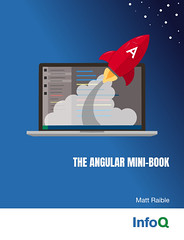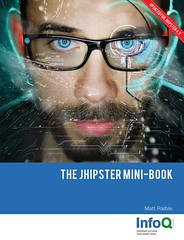I'm still amazed by all the traffic and comments received by my experience with JSF. In some cases it feels like I insulted some of these guys wives or something. Here's some good quotes from the comments:
The less than positive experience is because Matt wants to write an app while asking a million questions all over mailing lists and not investing the time to learn.
I think you're too in love with struts to have a clear sight on what's going on.
Pick your poison and stop bad-mouthing others because you don't get.
I admit that I was a bit harsh on JSF in my post. Here's why. I developed 5 simple apps this summer, all doing the same thing with different frameworks: Struts, Spring MVC, WebWork, Tapestry and JSF. All of them hooked into the same backend, which was Spring+Hibernate. I had a learning curve to overcome with WebWork, Tapestry and JSF. I already knew Struts and Spring MVC, so those versions where easy to develop with. Of the three (WebWork, Tapestry and JSF), I was able to complete the JSF version the fastest. It took me a 1 1/2 days for WebWork, 3 days for Tapestry and 1 day for JSF. Or so I thought.
The JSF app was pretty close to being finished, but I was missing one thing - a sortable/pageable table. And I hadn't written the test for my page classes yet. This was Wednesday. I made a post late that night on how much I liked the JSF-Spring integration library. If you'll notice in this post, I mentioned that I got the displaytag to work too (almost). I found that I had to use an empty tag to pull the list of users from my page bean into the request, and then the displaytag could render the list. This was almost perfect, but the <h:commandLink> didn't work, so I had no way of editing a record from the table.
At this point, it all started to break down - and my frustration began. I was sooo close to completing this application and so far (even with the minor snags I'd hit) it was the easiest one to develop. Juergen left a comment stating that Spring's core now had a DelegatingVariableResolver in its core. So I figured I'd make my application more "pure" and use that instead of the JSF-Spring integration library. This was my first mistake. The DelegatingVariableResolver from Spring didn't work with Sun's RI and only worked with MyFaces. I figured it wouldn't be hard to switch (JSF is a standard, right?) - so I went to it the next day. I'd also heard that MyFaces had a sortable/pageable dataGrid - so the switch seemed like a good idea.
The first bump in the road was that while the DelegateVariableResolver worked, MyFaces reported an error. The Spring guys blamed MyFaces and MyFaces blamed Spring. Result: it's a bug that no one will fix. I spent a couple hours being a good open-source citizen by 1) trying to fix it and 2) reporting it. The second bumb in the road was that I had to change a few things that worked in the RI but didn't work in MyFaces (I forget what now). However, this wasn't so bad since it also fixed a couple of issues.
Next I tried to use MyFace's <x:dataTable> to replace the display tag. Since it had a sortHeader component, I figured this would be easy. It turns out this component requires you to implement custom logic in your page bean. Things might've changed since July, but I doubt it. Lastly, aftering getting everything to work, I went to work on writing a jWebUnit test to test it all. While doing so, I found that it was almost impossible to test my edit screen. With other frameworks, I could specify a URL with a record id and then proceed to change form fields and push buttons. With JSF, there was no easy way to determine the URL. The rendered UI used heavy JavaScript and when you clicked on a link in the dataTable, this called a JavaScript function. I have no problems with JavaScript and I think it's a great technology. However, the current UI testing frameworks I use (jWebUnit and Canoo WebTest) use the Rhino JavaScript library (js.jar) and it sucks at JavaScript. It reports errors where there are no errors - and hence, I tend to exclude the JAR and disable JavaScript support in my tests. If there was better JavaScript support in these testing frameworks - I'd likely have to problems with JSF's "I post for every link" mantra.
In most of my development life, I've most often been a framework user rather than a developer. This means that if I find problems, I don't extend the framework - I look for other solutions. Call me whatever you like, but I'm just trying to get my job done and the project completed. I don't want to mess with the internals of a framework to make that happen. With JSF (and Tapestry too), you have to be more of a framework developer. You have to be willing to create your own components. These frameworks are designed as component frameworks and they want you to extend them. That's one of the major points of their architecture.
So here I am again, posting about JSF - which will undoubtably get an incredible amount of hits just because it has "JSF" in the title. Why? Because you can't ignore JSF. Even if you don't want to develop with it - there's going to be tons of jobs that require JSF in the near future. In fact, there are already quite a few. Surprisingly enough, in my job search last month, I has a more opportunities for JSF (and WebWork suprisingly enough) than Struts. Finding a Tapestry gig - good luck. Of course, I'm a consultant, not an employee - so I don't often don't get to choose frameworks for companies.
I think JSF is an immature technology that will rapidly mature. I hope it does b/c it was fairly easy to develop with - there were merely some minor bugs in the two implementations. These can be fixed. In reality, I think we should all quit bashing on JSF and jump in to try and make it better. Rather than complaining, let's try to help.
I've done my part and applied to be on the JSF Expert Group. They probably won't let me in though - everyone seems to link I hate JSF. If I had my way, I'd scrap the sucker and make Tapestry the JSF standard. 



 it and view the
it and view the